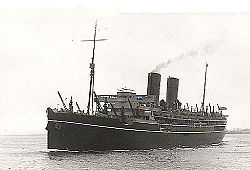SS Rajputana

| |
| Career (United Kingdom) | |
|---|---|
| Builder: | Harland and Wolff Greenock, Yard No. 661 at the River Clyde |
| Laid down: | 1925 |
| Launched: | 1926 |
| Acquired: | September 1939 |
| Commissioned: | December 1939 |
| Out of service: | 13 April 1941 |
| Reclassified: | Armed merchant cruiser |
| Homeport: | London |
| Fate: | torpedoed & sunk off Iceland in position 65°50′N 27°25′W / 65.833°N 27.417°WCoordinates: 65°50′N 27°25′W / 65.833°N 27.417°W |
| General characteristics | |
| Tonnage: |
16,568 gross register tons 8755 deadweight tons |
| Length: | 547 ft (167 m) |
| Beam: | 71 ft (22 m) |
| Propulsion: | quad expansion steam engine |
| Speed: | 17 knots |
| Complement: | 323 (as armed cruiser) |
| Armament: |
8 x 6 in (152 mm) 2 x 3 in (76 mm) (76.2 mm) |
| Armor: | none |
The SS Rajputana was a British passenger and cargo carrying ocean liner. She was built for the Peninsular & Oriental Steam Navigation Company at the Harland and Wolff docks on the River Clyde near Glasgow, Scotland in 1925. She one of the P&O 'R' class liners from 1925 that had the much of their interiors designed by Lord Inchcape's daughter Elsie Mackay[1]. Named after Rajputana region of western India, she sailed on a regular route between England and British India.
She was requisitioned into the Royal Navy on the onset of World War II and commissioned in December 1939 as the armed merchant cruiser HMS Rajputana. The installation of eight six-inch guns gave her the firepower of a light cruiser without the armoured protection. She was torpedoed and sunk off Iceland on 13 April 1941, after escorting a convoy across the North Atlantic.
World War II
In the Second Battle of the Atlantic HMS Rajputana escorted several North Atlantic convoys from Bermuda and Halifax under Captain F. H. Taylor, including BHX 42, BHX 45, BHX 49, BHX 52, BHX 54, BHX 61, BHX 64, BHX 71, BHX 83, BHX 94, BHX 101, BHX 111 and BHX 117
Her sister ships SS Rawalpindi, SS Ranchi and SS Ranpura were also converted to armed merchant cruisers. Except for small corvettes, the converted passenger ships like HMS Rajputana were the only armed protection for most of the early convoys. With their six-inch guns, they were the only escorts that could engage German surface ships. Very few convoys received the protection of the larger cruisers or battleships.
On 13 April 1941, four days after parting company with convoy HX 117, she was torpedoed by U-108 in the Denmark Strait west of Reykjavík, Iceland. She sunk over an hour later with the loss of 42 men, including her last civilian captain Commander C.T.O. Richardson. [1] A total of 283 of her crew were saved by the destroyer HMS Legion, some of them after spending 12 hours in overcrowded lifeboats. Among the survivors was Daniel Lionel Hanington, who later become a Rear Admiral in the Royal Canadian Navy.
Of her sister ships two survived the war. On 23 November 1939, while on "Northern Patrol" guarding the GIUK gap, HMS Rawalpindi engaged in battle against the German battlecruisers Scharnhorst and Gneisenau. She prevented the breakthrough of the ships, but was herself sunk southeast of Iceland in the Iceland-Faroe passage. [2] HMS Ranchi (F15) survived the war and was scrapped at Newport in 1953. [3] HMS Ranpura (F93) was sold to the Admiralty in 1943 and converted to a repair ship. She served in the Royal Navy as a fleet depot ship at least until 1960. [4] She took part in the 1956 British invasion of Egypt. [5]
Famous passengers
The P&O R-class ships could carry 307 first class and 288 second class passengers.
- On January 12, 1929 Lawrence of Arabia boarded the ship in Karachi, British India, arriving in Plymouth in February 1929.
- On August 29, 1931 Indian spiritual teacher Meher Baba departed Bombay for London on the SS Rajputana. Onboard he met with Mahatma Gandhi who was sailing to the second Round Table Conference in London. [2] It was here Baba showed him several pages of his missing book.
- On September 7, 1931 Egyptian Essayist and Author Muhammad Loutfi Goumah boarded the ship in Port Said to meet with Mahatma Gandhi, the meeting lasted for eight hours. [3]
References
- ↑ P & O Line Ships (and technical data) from 1920 to 1930
- ↑ Kalchuri, Bhau: "Meher Prabhu: Lord Meher, The Biography of the Avatar of the Age, Meher Baba", Manifestation, Inc. 1986. p. 1380
- ↑ The Biography of Muhammad Loutfi Goumah - Al-Hatyaa Al-Misreyya Al-Aama Lelketab- 2000 - Part I- P. 554 ISBN 977-01-6651-0
